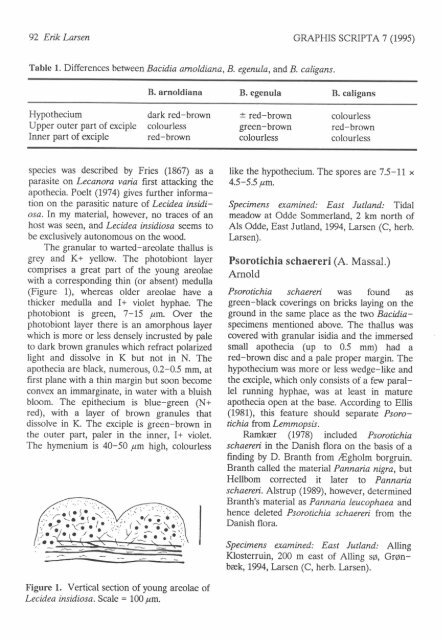GRAPHIS SCNIPTA - Universitetet i Oslo
GRAPHIS SCNIPTA - Universitetet i Oslo
GRAPHIS SCNIPTA - Universitetet i Oslo
Create successful ePaper yourself
Turn your PDF publications into a flip-book with our unique Google optimized e-Paper software.
9?, Enk Larsen GRAPHTS SCRTPTA 7 (Lees)<br />
Table 1. Differences between Bacid.ia amoldiana, B. egenula, and B. caligans.<br />
Hypothecium<br />
Upper outer part of exciple<br />
Inner part of exciple<br />
B. arnoldiana B. egenula B. caligans<br />
dark red-brown<br />
colourless<br />
red-brown<br />
species was described by Fries (L867) as a<br />
parasite on Lecanora varia first attacking the<br />
apothecia. Poelt (1974) gives further information<br />
on the parasitic nature of Lecidea insid,iosa.<br />
In my material, however, no traces of an<br />
host was seen, and Lecid,ea insid,iosc seems to<br />
be exclusively autonomous on the wood.<br />
The granular to warted-areolate thallus is<br />
grey and K+ yellow. The photobiont layer<br />
comprises a great part of the young areolae<br />
with a corresponding thin (or absent) medulla<br />
(Figure 1), whereas older areolae have a<br />
thicker medulla and I+ violet hyphae. The<br />
photobiont is green, 7 -15 ltm. Over the<br />
photobiont layer there is an amorphous layer<br />
which is more or less densely incrusted by pale<br />
to dark brown granules which refract polarized<br />
light and dissolve in K but not in N. The<br />
apothecia are black, numerous, 0.2-0.5 mm, at<br />
first plane with a thin margin but soon become<br />
convex an immarginate, in water with a bluish<br />
bloom. The epithecium is blue-green (N*<br />
red), with a layer of brown granules that<br />
dissolve in K. The exciple is green-brown in<br />
the outer part, paler in the inner, I+ violet.<br />
The hymenium is 40-50 pm high, colourless<br />
-J.. ;'-<br />
Figure 1. Vertical section of young areolae<br />
Lecidea insidiosa. Scale = 100,,nm.<br />
_...-<br />
rt/.J,<br />
o o Ol<br />
J^\<br />
z,oa.<br />
of<br />
I red-brown<br />
green-brown<br />
colourless<br />
colourless<br />
red-brown<br />
colourless<br />
like the hypothecium. The spores are 7 .5-11 x<br />
4.5-5.5 pm.<br />
Specimens examined: East Iutland; Tidal<br />
meadow at Odde Sommerland, 2 km north of<br />
Als Odde, East Jutland, 1994, I-arsen (C, herb.<br />
larsen).<br />
Psorotichia schaereri (A. Massal.)<br />
Arnold<br />
Psorotichia schaereri was found as<br />
green-black coverings on bricks laying on the<br />
ground in the same place as the two Bacidiaspecimens<br />
mentioned above. The thallus was<br />
covered with granular isidia and the immersed<br />
small apothecia (up to 0.5 mm) had a<br />
red-brown disc and a pale proper margin. The<br />
hypothecium was more or less wedge-like and<br />
the exciple, which only consists of a few parallel<br />
running hyphae, was at least in mature<br />
apothecia open at the base. According to Ellis<br />
(1981), this feature should separate Psorotichia<br />
from Lemmopsis.<br />
Ramkrer (1978) included Psorotichia<br />
schaereri in the Danish flora on the basis of a<br />
finding by D. Branth from .lEgholm borgruin.<br />
Branth called the material Pannaria nigra, but<br />
Hellbom corrected it later to Pannaia<br />
schaereri. Alstrup (1989), however, determined<br />
Branth's material as Pannaia leucophaea and<br />
hence deleted Psorotichia schaerei from the<br />
Danish flora.<br />
Specimens examined: East lutland: Alling<br />
Klosterruin, 2N m east of Alling s0, GrOnbrek,<br />
L994, larsen (C, herb. I-arsen).

















